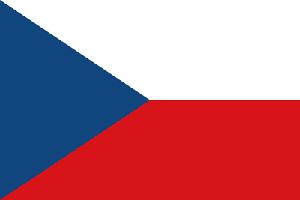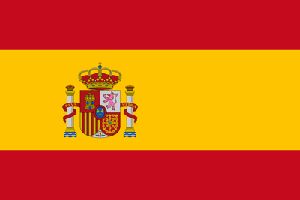Catalog of Holy Patrons and Attributes
Your comments below may also serve to improve our site. Did you find a mistake, do you have a wish? Write us! Thank you.
Alphabetical list of attributes and patron saints
Alms - Agnes of Bohemia, Zdislava Berka
Angel - Francis of Rome, Mary Magdalene, Matthew the Evangelist, Roch
Antlers - Eustace, Hubertus
Basket - Dorothea of Caesarea
Berla - Methodius, Nicholas, Procopius, Thomas Becket, bishops and abbots
Boat - Ursula
Book - Adalbert of Prague, Albertus Magnus, Anne, Augustine of Hippo, Barnabas, Bartholomew, Bede, Bernard of Clairvaux, Dominic, Ignatius of Loyola, John the Evangelist, Jan Sarkander, Catherine of Siena, Matthew the Apostle, Matthias, Norbert of Xanten, Paul, Pope Gregory I, Stephen, Thomas Aquinas
Book pierced by the sword - Boniface
Bucket - Florian
Bull - Luke the Evangelist
Carpentry tools - Joseph
Chalice - Barbara, Benedict of Nursia
Children - John Bosco
Church - Agnes of Bohemia, Gotthard of Hildesheim, Hedwig of Silesia
Clover trefoil - Patrick
Dagger - Lucy
Deer - Eustace, Hubertus, Giles
Devil - Procopius
Dove - Pope Gregory I, Teresa of Ávila, Thomas Aquinas
Dragon - Archangel Michael, George, Margaret of Antioch, Martha
Eagle - John the Evangelist
Eyes - Lucy
Feet barefoot - Hedwig of Silesia
Fire - Florian
Flash - Our Lady of Hostyn
Grape - Urban of Langres
Hammer - Eligius
Head - Denis of Paris
IHS/JHS letters - Bernardino of Siena, Peter Canisius, Stephen
Jug - Elizabeth of Hungary
Key - Benno of Meissen, Jan Sarkander, Peter
Knife - Bartholomew the Apostle
Lamb - Francis of Assisi, John the Baptist
Lamp - Clare of Assisi, Saint Lucy
Lilies - Aloysius Gonzaga, Anthony of Padua, Catherine of Siena, Dominic, Gabriel the archangel, Joseph, Scholastica
Lion - Ignatius of Antioch, Jerome, Mark the Evangelist, Thecla
Medical instruments - Cosmas and Damian
Millstone - Florian
Model of a church - Agnes of Bohemia, Hedwig of Silesia
Monstrance or chalice - Barbara, Clare of Assisi, Norbert of Xanten
Musical instrument - Cecilia, David
Nipples - Agatha of Sicily
Pliers - Agatha of Sicily, Apollonia
Quill - Augustin, Matthew the Apostle
Rooster - Vitus
Scull - Aloysius Gonzaga, Francis of Paola, Jerome, Mary Magdalene
Serpent - Our Lady Immaculata, Our Lady of Miracles, Patrick
Shell - Apostle James the Great
Sick person - Elizabeth of Hungary, Agnes of Bohemia, John of God, Charles Borromeo
Spear - Mary Magdalene de Pazzi, Michael the Archangel, Thomas the Apostle
Spear with banner - Wenceslaus I
Stars - John of Nepomuk, Virgin Mary
Stick - Alexis, Anthony the Great, Apostle James the Great, Joseph, Wendelin of Trier
Stones - Stephen
Sword - Barbara, Boniface, Joan of Arc, Lucy, Archangel Michael, Paul the Apostle, Thomas Becket
Wheel - Catherine of Alexandria
Still completing...
Dear readers, on the subject of attributes and patron saints, it should be noted that their common representation is not strict. We may even encounter a representation of a patron without his attributes. Likewise, one person may appear with a whole host of attributes that accompany him or her throughout the centuries in which he or she is depicted. Not infrequently, artistic vision has an influence on the depiction of a particular attribute with which a saint is associated and which largely defines him. It is artists who create paintings and statues of patrons. And their vision and actual needs are often reflected in the work. So think of the association of a patron with a particular attribute as the most common option, but one that may not always be fulfilled.
Archangel Gabriel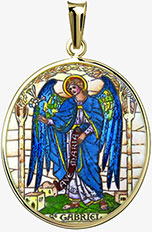 God's messenger, the herald. Archangel Gabriel is the patron saint of human messengers - people working in telecommunications, reporters, musicians, teachers, inspires and motivates artists. He leads hopeful parents to conceive, gives them strength, helps future mothers.
God's messenger, the herald. Archangel Gabriel is the patron saint of human messengers - people working in telecommunications, reporters, musicians, teachers, inspires and motivates artists. He leads hopeful parents to conceive, gives them strength, helps future mothers.
It is the Archangel Gabriel who heralds God's message to Mary about the birth of her son Jesus Christ. This Archangel was also the inspiration for Mohammed to write the spiritual text of Islam - the Qur'an. In the Roman Catholic Church, his memory is celebrated on September 29 (as part of the feast of the Archangels Michael, Gabriel and Raphael), according to older calendars used in the traditional liturgy on March 24.
The main attributes of the Archangel Gabriel include lily, spear and shield.
Archangel Michael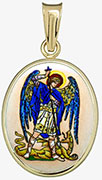 "He who looks like God" is considered the leader of the archangels himself. A winged knight in celestial armor with a fiery spear overcoming the antichrist in the form of a dragon. Archangel Michael is the patron saint of all police officers and soldiers, as well as merchants and the dying. He is the protector against evil and is considered the embodiment of God's justice. In paradise, Adam taught how to cultivate the land and how to take care of the family. According to legend, it was he who gave Joan of Arc the courage to lead France in the Hundred Years' War. Archangel Michael helps us with heroic deeds in the most difficult situations, frees us from fear and gives us courage. His feast day is celebrated on September 29 together with the archangel Gabriel and Raphael.
"He who looks like God" is considered the leader of the archangels himself. A winged knight in celestial armor with a fiery spear overcoming the antichrist in the form of a dragon. Archangel Michael is the patron saint of all police officers and soldiers, as well as merchants and the dying. He is the protector against evil and is considered the embodiment of God's justice. In paradise, Adam taught how to cultivate the land and how to take care of the family. According to legend, it was he who gave Joan of Arc the courage to lead France in the Hundred Years' War. Archangel Michael helps us with heroic deeds in the most difficult situations, frees us from fear and gives us courage. His feast day is celebrated on September 29 together with the archangel Gabriel and Raphael.
The main attributes of the Archangel Michael are a spear or a sword, armor, banners and the dragon in the “great battle of heaven”.
Archangel Raphael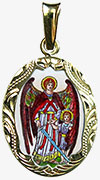 God's messenger accompanying and protecting little Tobiah. From the Hebrew words "rapha" (doctor, healer) and "el" (God), God's healer. Archangel Raphael is a patron saint of the blind, all doctors, pharmacists and nurses, also patron of trade, education and pilgrimage. Archangel Rafael is an angel of love, health and the right choice. Archangel Rafael prevents the withering of love, cures all forms of disease in humans and animals, brings happiness during operations and then adds lost strength. It helps in important decisions and protects pilgrims on the road.
God's messenger accompanying and protecting little Tobiah. From the Hebrew words "rapha" (doctor, healer) and "el" (God), God's healer. Archangel Raphael is a patron saint of the blind, all doctors, pharmacists and nurses, also patron of trade, education and pilgrimage. Archangel Rafael is an angel of love, health and the right choice. Archangel Rafael prevents the withering of love, cures all forms of disease in humans and animals, brings happiness during operations and then adds lost strength. It helps in important decisions and protects pilgrims on the road.
The attributes of the Archangel Raphael include a staff that represents healing or a sword protecting Tobit. Sometimes Raphael is depicted with a fish which he uses in his healing work.
Archangel Uriel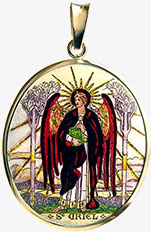 In Hebrew, Uriel means God's light. Archangel Uriel is depicted in a red cloak, like a light-radiant archangel. Archangel Uriel is the patron saint of wisdom. He brings inspiration, motivation and fresh ideas. It was the Archangel Uriel who warned Noah of the Flood and also brought Kabbalah to the people. He comes to help with storms, floods or fires because he is the ruler of the weather.
In Hebrew, Uriel means God's light. Archangel Uriel is depicted in a red cloak, like a light-radiant archangel. Archangel Uriel is the patron saint of wisdom. He brings inspiration, motivation and fresh ideas. It was the Archangel Uriel who warned Noah of the Flood and also brought Kabbalah to the people. He comes to help with storms, floods or fires because he is the ruler of the weather.
His attribute are a book or a scroll, symbolizing wisdom, God's light, or a flame that symbolizes God's truth.
Assumption of the Virgin Mary The Assumption of the Virgin Mary, also Assumptio. Mary is often depicted here in the middle of the angelic churches with which she is carried to heaven. When the Immaculate Virgin finished her earthly life, she was taken with her body and soul to the glory of heaven and exalted by the Lord as the queen of all creation. One of the most important Marian holidays is celebrated on August 15.
The Assumption of the Virgin Mary, also Assumptio. Mary is often depicted here in the middle of the angelic churches with which she is carried to heaven. When the Immaculate Virgin finished her earthly life, she was taken with her body and soul to the glory of heaven and exalted by the Lord as the queen of all creation. One of the most important Marian holidays is celebrated on August 15.
Attributes here are the Virgin Mary, who is dressed in a white dress and blue cloak, angels, coronation and depiction of heaven often with a golden glow.
Baby Jesus of Prague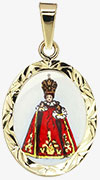 The statuette of the Infant Jesus of Prague comes from 16th century Spain. It was modeled by a monk to whom Jesus miraculously appeared. The statue was owned by Saint Theresa of Jesus, who greatly revered Jesus' childhood and spread respect for the Child Jesus throughout Spain. The statuette came to Prague as a gift. In 1631, Prague was occupied by the Saxons and the statue was damaged. However, father Cyril from the Mother of God found it after the war and had it repaired. Since then, Baby Jesus has blessed the whole of Prague and miraculous healings have been attributed to him. In 1655, the statue was ceremoniously crowned by the Bishop of Prague. The number of miracles and hearings grew, and for crowds of worshipers, the statue was moved to its current location in 1741. In 1754, empress Maria Theresa dedicated a hand-embroidered dress to Baby Jesus. The worship of the Infant Jesus of Prague began to spread in all countries of the Austrian Empire. At the turn of the 19th and 20th centuries, respect for the Baby Jesus spread throughout the world. In 1993, Discalced Carmelites returned to the Church of Our Lady Victorious in Prague. Pope Benedict XVI visited the statue of the Infant Jesus in 2009. In his speech, he stated that the Infant Jesus of Prague presented God's closeness and love with his childish tenderness.
The statuette of the Infant Jesus of Prague comes from 16th century Spain. It was modeled by a monk to whom Jesus miraculously appeared. The statue was owned by Saint Theresa of Jesus, who greatly revered Jesus' childhood and spread respect for the Child Jesus throughout Spain. The statuette came to Prague as a gift. In 1631, Prague was occupied by the Saxons and the statue was damaged. However, father Cyril from the Mother of God found it after the war and had it repaired. Since then, Baby Jesus has blessed the whole of Prague and miraculous healings have been attributed to him. In 1655, the statue was ceremoniously crowned by the Bishop of Prague. The number of miracles and hearings grew, and for crowds of worshipers, the statue was moved to its current location in 1741. In 1754, empress Maria Theresa dedicated a hand-embroidered dress to Baby Jesus. The worship of the Infant Jesus of Prague began to spread in all countries of the Austrian Empire. At the turn of the 19th and 20th centuries, respect for the Baby Jesus spread throughout the world. In 1993, Discalced Carmelites returned to the Church of Our Lady Victorious in Prague. Pope Benedict XVI visited the statue of the Infant Jesus in 2009. In his speech, he stated that the Infant Jesus of Prague presented God's closeness and love with his childish tenderness.
White dress is dressed for festive, Easter and Christmas times.
Red dress is worn for Holy Week, Pentecost and Holy Cross holidays.
Crimson dress is a sign of repentance during Lent and Advent.
We can see green dress most often at the Baby Jesus. Green is the color for the liturgical interlude. It is the color of life and hope.
Baby Jesus has a blue dress for the Marian feast days, it's a festive color.
In addition to the dress, the attribute of the Prague Jesuit is a distinctive golden crown, an imperial apple and a blessing right hand.
Holy Family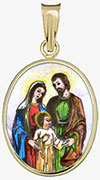 The Holy Family in Christianity refers to the family consisting of the Virgin Mary, st. Joseph and Jesus Christ. It is cited as the best example of love, virtue and harmony and a model for the lives of all Catholic families. The feast of the Holy Family falls on December 27.
The Holy Family in Christianity refers to the family consisting of the Virgin Mary, st. Joseph and Jesus Christ. It is cited as the best example of love, virtue and harmony and a model for the lives of all Catholic families. The feast of the Holy Family falls on December 27.
The attributes are a trio of saints with a halo in plain clothing. The Virgin Mary is most often depicted in a blue cloak with a red dress, sometimes with a white mantle.
Immaculate Conception The Virgin Mary of the Immaculate Conception - also Immaculata - which is an abbreviated term immaculata conceptio. It refers to the dogma of the Immaculate Conception of the Virgin Mary in her mother's womb (according to the apocrypha of St. Anne). Therefore it does not apply to the conception of Jesus Christ.
The Virgin Mary of the Immaculate Conception - also Immaculata - which is an abbreviated term immaculata conceptio. It refers to the dogma of the Immaculate Conception of the Virgin Mary in her mother's womb (according to the apocrypha of St. Anne). Therefore it does not apply to the conception of Jesus Christ.
She is depicted with hands clasped in prayer, standing on a crescent moon or on a sphere depicting the world.
Jesus Christ - Crucifixion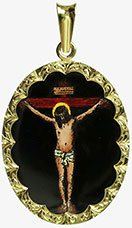 Jesus Christ, Jesus of Nazareth or the Messiah and his Crucifixion. Jesus was judged by Pilate of Pontus and subsequently crucified on a hill called Golgotha. The oldest depiction of the crucified Christ dates from the 6th century. The Christian faith is based on the fact that Jesus Christ died for each of us. His sacrifice is that the result of our wrongdoing (sin) fell on him, instead of us. We commemorate the death of Jesus Christ on Good Friday, always before Easter Sunday.
Jesus Christ, Jesus of Nazareth or the Messiah and his Crucifixion. Jesus was judged by Pilate of Pontus and subsequently crucified on a hill called Golgotha. The oldest depiction of the crucified Christ dates from the 6th century. The Christian faith is based on the fact that Jesus Christ died for each of us. His sacrifice is that the result of our wrongdoing (sin) fell on him, instead of us. We commemorate the death of Jesus Christ on Good Friday, always before Easter Sunday.
The crucifixion of Jesus Christ is the cross and the body of Christ itself. Then there are the wounds he suffered with the spikes and spear of a Roman soldier, the crown of thorns and the inscription INRI, which is an abbreviation - Iesus Nazarenus Rex Iudaeorum (Jesus of Nazareth, King of the Jews).
John the Baptist John the Baptist, an ascetic man of a skinny figure dressed in leather clothes. A man sent from God to bear witness to the light so that through him everyone might believe. Son of Zechariah and his wife Elizabeth walking through the desserts with a staff with a cross at the end. Protector of winemakers, chimney sweeps, architects, masons, guardian of singers, dancers, smiths, and weavers.
John the Baptist, an ascetic man of a skinny figure dressed in leather clothes. A man sent from God to bear witness to the light so that through him everyone might believe. Son of Zechariah and his wife Elizabeth walking through the desserts with a staff with a cross at the end. Protector of winemakers, chimney sweeps, architects, masons, guardian of singers, dancers, smiths, and weavers.
Still young he started wandering the desserts, eating honey of wild bees, roots, and grasshoppers. He wanted to understand life and became a preacher at the age of 30 preaching the coming of Messiah. With his way of living, he became an idol for many people who he baptized in the Jordan river - among others also Jesus Christ.
John the Baptist later became the patron saint of Order of Knights of the Hospital of Saint John of Jerusalem (or Knights Hospitaller in short) as well as patron of Malta, Florence, city of Porto in Portugal, protector of Puerto Rico, and its capital San Juan. All around the world they celebrate his patronage on June 24th with burning bonfires and other traditions.
The attribute is a staff topped with a cross, sometimes a lamb or a severed head on a bowl.
Our Lady Mother of Good Advice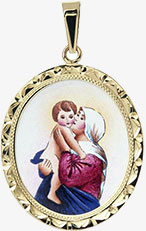 In Albania, near Skutara, there was a much-visited Marian pilgrimage site. Pilgrims were visiting the Virgin Mary, Mother of Good Counsel, for almost 200 years. Then Marian reverence began to wane, piety disappeared, purity of morals declined. One day the painting, painted on plaster came loose from the church wall, rose to a height and surrounded by a cloud, hoved across the sea to Genazzano. On St. Mark's Day 1467, it remained on the wall of the Augustinian church under construction, where it is worshiped to this day.
In Albania, near Skutara, there was a much-visited Marian pilgrimage site. Pilgrims were visiting the Virgin Mary, Mother of Good Counsel, for almost 200 years. Then Marian reverence began to wane, piety disappeared, purity of morals declined. One day the painting, painted on plaster came loose from the church wall, rose to a height and surrounded by a cloud, hoved across the sea to Genazzano. On St. Mark's Day 1467, it remained on the wall of the Augustinian church under construction, where it is worshiped to this day.
The attribute is a Madonna in a plain garment who, whispering, bows or winds her way to her child.
Our Lady of Częstochowa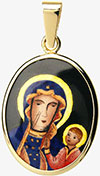 The Black Madonna of Częstochowa (Polish: Czarna Madonna or Matka Boska Częstochowska) is a medieval icon depicting the Virgin Mary with Jesus.
The Black Madonna of Częstochowa (Polish: Czarna Madonna or Matka Boska Częstochowska) is a medieval icon depicting the Virgin Mary with Jesus.
The Black Madonna is the most revered Polish religious artifact, she is the protector of Poland. Its feast day, August 26, was officially established by Pius X in 1904. On this day, walking pilgrimages to Jasna Góra Monastery take place every year from many parts of Poland.
The attributes are the dark skin of both the Madonna and the Baby Jesus and the scar on the Madonna's right cheek, which refers to the damage to the original image by Hussites.
Our Lady of Fatima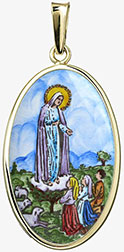 The Virgin Mary of Fátima appeared in Portugal to three shepherd children in the fields of Fatima for six consecutive months every thirteenth day. The Blessed Virgin Mary or also the Lady of the Rosary of Fátima called for the daily praying of the rosary, which will bring peace and the end of the war. She spoke of an coming miracle, which was later described as the Miracle of the Sun. It took place on October 13, 1917 in front of at least 30,000 people. Various visions that occurred that day were described. From the inexplicable movements of the sun, to the revelation of several holy patrons who blessed the people. People also described the miraculous drying of all wet clothes after the heavy rain that preceded. We commemorate the Virgin Mary of Fatima on May 13, on anniversary of her first apparition, and October 13, which is associated with the Miracle of the Sun.
The Virgin Mary of Fátima appeared in Portugal to three shepherd children in the fields of Fatima for six consecutive months every thirteenth day. The Blessed Virgin Mary or also the Lady of the Rosary of Fátima called for the daily praying of the rosary, which will bring peace and the end of the war. She spoke of an coming miracle, which was later described as the Miracle of the Sun. It took place on October 13, 1917 in front of at least 30,000 people. Various visions that occurred that day were described. From the inexplicable movements of the sun, to the revelation of several holy patrons who blessed the people. People also described the miraculous drying of all wet clothes after the heavy rain that preceded. We commemorate the Virgin Mary of Fatima on May 13, on anniversary of her first apparition, and October 13, which is associated with the Miracle of the Sun.
The attributes are the white dress of the Madonna, a rosary in her hands and three shepherds, sometimes with sheep.
Our Lady of Guadalupe Saint Maria, the Mother of God, is said to have appeared on the top of Tepeyac Hill in Mexico as a Native American girl. According to the legend, she spoke to Juan Diego in nahuatic (the native mexican language) on his way to Mexico City for a morning mass. The year was 1531.
Saint Maria, the Mother of God, is said to have appeared on the top of Tepeyac Hill in Mexico as a Native American girl. According to the legend, she spoke to Juan Diego in nahuatic (the native mexican language) on his way to Mexico City for a morning mass. The year was 1531.
The Virgin Mary asked Juan Diego to have a consecrated church built here with the help of the bishop. But Bishop Juan de Zumárraga was skeptical about Diego and demanded a proof. So the Mother of God sent Diego to collect roses and bring them to the bishop. Diego indeed collected them into his Indian tilma. And then, as he presented them to the bishop, a perfect image of the Virgin of Guadalupe appeared on the exposed inner side. The bishop was astonished and immediately convinced, he had the Church of Our Lady of Guadalupe built at the designated place. Juan Diego's cloak has been miraculously well preserved to this day in the Basilica de Guadalupe in Mexico City.
The attributes are the aura, the red dress and blue-green cloak of the Madonna, the dark moon and the angel clinging to the fold of the cloak.
Our Lady of Hostyn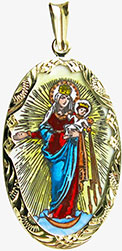 The Virgin Mary of Hostyn stands on the crescent with the baby Jesus in her arms. Baby Jesus is throwing lightning toward the ground. According to the legend recorded for us by Bohuslav Balbin, half a million Tatars invaded Moravian territory sometime around 1241. Thousands of Moravians were therefore fleeing from very vicious raiders to safety. Their refuge was to become the familiar hill of the Hostyn Hills. Here they prayed and pleaded with the Virgin for help and water. What happened gave St. Hostyn its name and is still remembered today. On the mountainside a spring of water burst from the ground, and a mighty storm of lightning scattered the Tartar encampment beneath the hill of the Hostyn. The image of the baby Jesus throwing lightning is a great rarity. We are glad to know the circumstances of its creation.
The Virgin Mary of Hostyn stands on the crescent with the baby Jesus in her arms. Baby Jesus is throwing lightning toward the ground. According to the legend recorded for us by Bohuslav Balbin, half a million Tatars invaded Moravian territory sometime around 1241. Thousands of Moravians were therefore fleeing from very vicious raiders to safety. Their refuge was to become the familiar hill of the Hostyn Hills. Here they prayed and pleaded with the Virgin for help and water. What happened gave St. Hostyn its name and is still remembered today. On the mountainside a spring of water burst from the ground, and a mighty storm of lightning scattered the Tartar encampment beneath the hill of the Hostyn. The image of the baby Jesus throwing lightning is a great rarity. We are glad to know the circumstances of its creation.
The Virgin Mary of Hostyn with Jesus holding a bunch of lightning bolts, is meant to protect and give courage in difficult situations and bring good luck.
The attributes are the golden glow around the Madonna, the lightning from the hands of Jesus, the moon that the Madonna is stepping over, the blue cloak, the red dress and the white shroud.
Our Lady of Lourdes She is the patroness of the sick people. Our Lady of Lourdes appeared eighteen times to the then fourteen-year-old girl Bernadette Soubirous in the small southern French village of Lourdes, in the foothills of the Pyrenees. She told her that she was the Immaculate Conception and asked for prayers and repentance for sinners. Blessed Virgin Mary showed to Bernadette the place where she had found a healing spring, bringing relief and healing to many patients.
She is the patroness of the sick people. Our Lady of Lourdes appeared eighteen times to the then fourteen-year-old girl Bernadette Soubirous in the small southern French village of Lourdes, in the foothills of the Pyrenees. She told her that she was the Immaculate Conception and asked for prayers and repentance for sinners. Blessed Virgin Mary showed to Bernadette the place where she had found a healing spring, bringing relief and healing to many patients.
She is depicted in a cave, in a light robe girded with a blue sash, with her hands clasped in prayer. We commemorate the Feast of Our Lady of Lourdes on February 11, World Day of the Sick.
Its attributes include a cave, a spring of pure water, a blue sash and Saint Bernadette.
Our Lady of Mount Carmel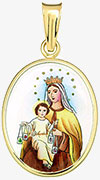 Our Lady of Mount Carmel is also referred to as the Mother of St. Scapular. The scapular received the Carmelite Order through Saint Simon Stock, who longed to spread respect for the Virgin Mary. Wearing a scapular (it is also possible to wear a Scapular medal) is to be accompanied by our willingness to dress in the life of the Virgin Mary and, as she does, to enter the service of the work of salvation. It is about living an intimate relationship with the Virgin Mary and Christ and participating with them in God's work.
Our Lady of Mount Carmel is also referred to as the Mother of St. Scapular. The scapular received the Carmelite Order through Saint Simon Stock, who longed to spread respect for the Virgin Mary. Wearing a scapular (it is also possible to wear a Scapular medal) is to be accompanied by our willingness to dress in the life of the Virgin Mary and, as she does, to enter the service of the work of salvation. It is about living an intimate relationship with the Virgin Mary and Christ and participating with them in God's work.
The name of the Carmel Madonna comes from Mount Carmel. On this mountain from the earliest Christian times, hermits led a penitent life and worshiped the Mother of God. At the beginning of the 13th century, they established a religious order there. The essence of Mary's title "Virgin Mary of Carmel" was an expression of the goodnesses that the Carmelite Order received from the chosen patroness.
We remember the Virgin Mary of Carmel on July 16.
The attributes are a crown, twelve stars and a scapular, which baby Jesus holds in each hand.
Our Lady of the Miraculous Medal Our Lady of Miracle, also known as Our Lady of Grace, appeared to Catherine Labouré in Rue du Bac in Paris, asked her to make a medal. Those who wear it around their necks with confidence will receive great graces. And so it happened.
Our Lady of Miracle, also known as Our Lady of Grace, appeared to Catherine Labouré in Rue du Bac in Paris, asked her to make a medal. Those who wear it around their necks with confidence will receive great graces. And so it happened.
The figure of the Virgin Mary stands on the globe and crushes the snake with her feet. According to the Mother of God, the sphere represents the whole world, especially France and each person separately. The image of the serpent reminds us of God's promise of the salvation of mankind and the ultimate victory over Evil.
In addition to the aforementioned attributes of the serpent, the globe, and the streams of the sacrament from her hands, the inscription on the back of the Miraculous Medallion, which reveals a capital letter M and a cross surrounded by twelve stars and two hearts, is an interesting attribute. One with a crown of thorns, the other pierced with a dagger.
Our Lady of the Seven Sorrows Sometimes the Virgin Mary of Sorrows - in Latin Mater Dolorosa - is a depiction or reminder of the Virgin Mary associated with the pain and suffering she went through. The word Seven Sorrows refers to the seven painful events that the Virgin Mary went through and that are mentioned in the Bible. The Church began to commemorate the Feast of Our Lady of Sorrows primarily to commemorate the earthly suffering of the Mother of God associated with the suffering of her Son.
Sometimes the Virgin Mary of Sorrows - in Latin Mater Dolorosa - is a depiction or reminder of the Virgin Mary associated with the pain and suffering she went through. The word Seven Sorrows refers to the seven painful events that the Virgin Mary went through and that are mentioned in the Bible. The Church began to commemorate the Feast of Our Lady of Sorrows primarily to commemorate the earthly suffering of the Mother of God associated with the suffering of her Son.
Our Lady of the Seven Sorrows is the main patron saint of Slovakia. Her day is a national holiday in Slovakia. The Church commemorates the Virgin Mary of the Seven Sorrows on the Friday after Mortal Sunday (5th Sunday of Lent) and September 15.
The attribute is often just the head of the suffering Madonna covered by a cloak in shades of blue, purple or green.
Padre Pio of Pietrelcina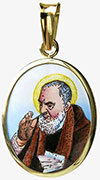 St. Pio of Pietrelcina with gloves hiding his stigmata. He experienced Christ's torment on his own body, often taking on the sins of others. Pater Pio is the patron saint of Catholic adolescents looking for answers. It gives strength and takes away our pain.
St. Pio of Pietrelcina with gloves hiding his stigmata. He experienced Christ's torment on his own body, often taking on the sins of others. Pater Pio is the patron saint of Catholic adolescents looking for answers. It gives strength and takes away our pain.
Father Pio died in San Giovanni Rotondo. We honour him on September 23.
The attributes are the saint's gloves hiding the stigmata and a book or pages of paper.
Sacred Heart of Jesus The emphasis on the Heart of Christ underscores the reality of the true humanity of God's Son, Jesus Christ. Humanity, which manifests itself not only in reason and desire, but also in humanity full of emotion. Jesus' death on the cross was officially confirmed by a piercing of his side resp. his Heart as was described in the Gospel of John. The pierced Heart of Jesus refers to Jesus' Sacrifice on the Cross. We commemorate this on June 19 with the Feasts of the Sacred Heart of Jesus.
The emphasis on the Heart of Christ underscores the reality of the true humanity of God's Son, Jesus Christ. Humanity, which manifests itself not only in reason and desire, but also in humanity full of emotion. Jesus' death on the cross was officially confirmed by a piercing of his side resp. his Heart as was described in the Gospel of John. The pierced Heart of Jesus refers to Jesus' Sacrifice on the Cross. We commemorate this on June 19 with the Feasts of the Sacred Heart of Jesus.
The attribute is the sometimes flaming, sometimes glowing or dagger-pierced heart of Jesus Christ.
Saint Agnes Patroness of the Czech Republic and since 1991 also the patroness of gas workers. Saint Agnes (Anezka Premyslovna) called Czech, came from a Premyslid family. As a royal daughter, they wanted to marry her several times not only to the king, but also to the emperor. However, she preferred the service of Christ and living in perfect poverty. Agnes is the only woman who also founded the masculine order. In 1237, Pope Gregory IX. confirmed at her request the Prague Hospital Brotherhood as the Knights of the Red Star. According to biographers, Agnes was endowed with clairvoyant vision and the power to perform miracles. She had seen beforehand the death of King Premysl Otakar II. in the Moravian field. She miraculously helped the suffering, afflicted with disease and hunger. In addition to sudden healings, her intercession also describes the miracle of discovering food in a monastery during a time of great need and starvation, when the Czech nation was humiliated by the Branibor. She gave hope and encouragement. She herself was very patient in suffering, excelled in the extraordinary humility and love for which she had a role model in Jesus. As John Paul II wrote: "She fed the hungry, cared for the sick, cared for the elderly, encouraged the helpless and was able to spread peace and reconciliation, comfort and shed new hope." With her canonization the Czech nation could feel her intercession in liberation from the totalitarian regime in 1989. St. Agnes of Bohemia is commemorated on November 13.
Patroness of the Czech Republic and since 1991 also the patroness of gas workers. Saint Agnes (Anezka Premyslovna) called Czech, came from a Premyslid family. As a royal daughter, they wanted to marry her several times not only to the king, but also to the emperor. However, she preferred the service of Christ and living in perfect poverty. Agnes is the only woman who also founded the masculine order. In 1237, Pope Gregory IX. confirmed at her request the Prague Hospital Brotherhood as the Knights of the Red Star. According to biographers, Agnes was endowed with clairvoyant vision and the power to perform miracles. She had seen beforehand the death of King Premysl Otakar II. in the Moravian field. She miraculously helped the suffering, afflicted with disease and hunger. In addition to sudden healings, her intercession also describes the miracle of discovering food in a monastery during a time of great need and starvation, when the Czech nation was humiliated by the Branibor. She gave hope and encouragement. She herself was very patient in suffering, excelled in the extraordinary humility and love for which she had a role model in Jesus. As John Paul II wrote: "She fed the hungry, cared for the sick, cared for the elderly, encouraged the helpless and was able to spread peace and reconciliation, comfort and shed new hope." With her canonization the Czech nation could feel her intercession in liberation from the totalitarian regime in 1989. St. Agnes of Bohemia is commemorated on November 13.
Among her attributes are a church, alms, a crown and a religious dress.
Saint Anne St. Anne was the mother of the Virgin Mary and the grandmother of Jesus Christ. Anne's name is interpreted as loving and kind.
St. Anne was the mother of the Virgin Mary and the grandmother of Jesus Christ. Anne's name is interpreted as loving and kind.
Saint Anne became the protector of mothers and marriage, happy childbirth, the patron saint of miners, millers, carpenters, weavers, tailors, rope makers and also grooms. Her power protects cities such as Florence, Innsbruck or Naples. Devout Christians came to her to pray for rain, against the storm but also for finding lost objects. St. Anne's Day is celebrated on July 26.
The attributes are a royal crown and a purple dress, a golden apple and a little Virgin Mary - as a child, often in a pink dress.
Saint Anthony The Franciscan monk, theologian and preacher also called saint Anthony of Padua or Anthony of Lisbon, is undoubtedly one of the most famous saints and Franciscans. Saint Anthony was born in Lisbon, Portugal in 1195 and his parents named him Ferdinand. His mother Teresa Pais Taveira and father Vicente Martins were of noble birth.
The Franciscan monk, theologian and preacher also called saint Anthony of Padua or Anthony of Lisbon, is undoubtedly one of the most famous saints and Franciscans. Saint Anthony was born in Lisbon, Portugal in 1195 and his parents named him Ferdinand. His mother Teresa Pais Taveira and father Vicente Martins were of noble birth.
In his youth, Anthony joined the Augustinian Order in Lisbon. He decided to faithfully carry out the gospel principles. He converted to the Franciscans and became a priest. He longed for missionary work in Africa but God decided otherwise because he landed in Sicily. After revealing his excellent knowledge and talents, which he hid in humility, he concentrated on preaching. Francis was commissioned to teach theology in Bologna and elsewhere. Anthony passed not only through northern Italy but also through southern France, teaching that humility, poverty, patience and obedience are the languages of the Holy Spirit by which we testify of Christ. He always emphasized the need for the sacrament of reconciliation. He died prematurely in Arcelle near Padua. Saint Anthony is the patron saint of Franciscans, travelers, miners and bakers, fiancés, spouses and families. The saint, who is at the same time the patron saint of lovers, passengers but also lost things, is called for a happy birth and against infertility. The feast of this "saint of the whole world" as the Pope Leo XIII. called him, we commemorate on June 13.
His attributes are a monk's robe, the child Jesus in his arms and a book or lily.
Saint Bernadette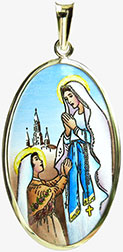 Nun and visionary saint Bernadette is the patroness of shepherds and the helper of sick people. Saint Bernadette was born as Bernadette Soubirous on January 7, 1844 in Lourdes, France. In Lourdes, where she lived, the Virgin Mary appeared to her many times. Virgin Mary showed to the young girl where to find a forgotten healing spring and asked her to have a church built on the spot. After overcoming certain difficulties, Bernadette did find the healing spring. When the blind man saw again after washing with its water, many people began to come to Lourdes after this miracle. Bernadette later became a nun. However, her whole life was in poor health, she died at the age of 35. Lourdes has become one of the most important places of pilgrimage in the world thanks to her visions. Bernadette was beatified in 1925 and declared a saint eight years later. We celebrate the commemoration of saint Bernadette on April 16.
Nun and visionary saint Bernadette is the patroness of shepherds and the helper of sick people. Saint Bernadette was born as Bernadette Soubirous on January 7, 1844 in Lourdes, France. In Lourdes, where she lived, the Virgin Mary appeared to her many times. Virgin Mary showed to the young girl where to find a forgotten healing spring and asked her to have a church built on the spot. After overcoming certain difficulties, Bernadette did find the healing spring. When the blind man saw again after washing with its water, many people began to come to Lourdes after this miracle. Bernadette later became a nun. However, her whole life was in poor health, she died at the age of 35. Lourdes has become one of the most important places of pilgrimage in the world thanks to her visions. Bernadette was beatified in 1925 and declared a saint eight years later. We celebrate the commemoration of saint Bernadette on April 16.
Her attributes are the rosary and the Virgin Mary in the Lourdes cave.
Saint Cecilia Saint Cecilia was a Roman martyr and a holy Catholic and Orthodox church and is still one of the most popular saints. She is the patron saint of sacred music, musicians, singers, poets, craftsmen making musical instruments and the blind. Saint Cecilia came from the ancient Roman Cecili family. She became an ardent Christian at an early age. She wore a noble dress, but she wore a sackcloth shirt underneath. She did not tolerate entertainment, but learned music and singing so that she could praise God in this way. She made a vow of eternal virginity. She died a martyr's death for her Christian faith. We commemorate the memory of saint Cecilia on November 22.
Saint Cecilia was a Roman martyr and a holy Catholic and Orthodox church and is still one of the most popular saints. She is the patron saint of sacred music, musicians, singers, poets, craftsmen making musical instruments and the blind. Saint Cecilia came from the ancient Roman Cecili family. She became an ardent Christian at an early age. She wore a noble dress, but she wore a sackcloth shirt underneath. She did not tolerate entertainment, but learned music and singing so that she could praise God in this way. She made a vow of eternal virginity. She died a martyr's death for her Christian faith. We commemorate the memory of saint Cecilia on November 22.
The attributes of saint Cecilia are a wreath of lilies or roses and an organ or other musical instrument.
Saint Christopher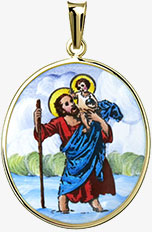 A holy martyr and one of the 14 holy helpers. He has always been one of the most popular and revered Christian saints.
A holy martyr and one of the 14 holy helpers. He has always been one of the most popular and revered Christian saints.
Saint Christopher is the patron saint of pilgrims, motorists and all passengers. Pilots, sailors, drivers, but also traders, athletes, doctors, miners and carpenters. He is called in bad weather, against infections and natural disasters, he is called as a helper in an emergency. He also protects against infections, plague, fire and water hazards. He is the patron saint of air rescuers. His attributes are: the child Jesus, a stick (mostly growing), possibly a tree, a wider stream of water and a man of huge stature, hermit.
He is often depicted as a man whose upbringing is close to the figure of Goliath, in the clothes of a pilgrim carrying a child Jesus Christ on his shoulders across a turbulent river, which rests on a strong stick. Legend has it that as a young and gifted man, he settled by the river to help people overcome a dangerous ford. A little boy once asked him for a help. So he laid him kindly on his shoulders but as he stepped into the water, the child grew heavier with each step. The water began to swell and reached the other bank only with maximum effort. Then he said to the boy, "It seemed to me that I was carrying the whole world on my shoulders." And the boy answered him, You carried more, because you carried its creator and your Lord. I am Jesus Christ, the king you are looking for. And because you have done good deeds, your sins are forgiven. Put your stick in the ground and the next day it will be like a tree full of flowers and fruits. The Christian world commemorates this holy martyr on July 25.
Its attributes are: the child Jesus, a staff (usually green), possibly a tree, a wider watercourse and a man of huge stature, a hermit.
Saint Florian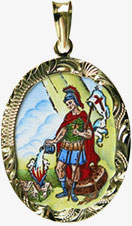 St. Florian of Lorch, a Catholic priest and martyr, is considered the patron saint of fire-related professions - firefighters, potters, blacksmiths, chimney sweeps, metallurgists, bakers, bakers and also miners. His cult was widespread in the Czech and Austrian lands, where his statues protect against fire.
St. Florian of Lorch, a Catholic priest and martyr, is considered the patron saint of fire-related professions - firefighters, potters, blacksmiths, chimney sweeps, metallurgists, bakers, bakers and also miners. His cult was widespread in the Czech and Austrian lands, where his statues protect against fire.
He is the patron saint of Upper Austria, Bologna, Krakow and the whole of Poland. He is called as a protector against drought, fire, floods and crop failure. He is usually depicted in the clothes of a Roman soldier with a bucket, or directly extinguishing a fire. Florian was an important officer in the Roman army. When he came to the aid of 40 imprisoned Christians, he was caught and ended up in court, where he fearlessly professed his faith. Imperial Deputy Aquilinus sentenced him to death. Florian said, "Serving to the army, I worshiped God in secret. I will listen in military matters, but as a Christian I will not be forced to deny Christ and worship dead idols."
The legendary treatise speaks of his double flogging, which failed to break his allegiance or weaken his love. In the end he was killed by a heavy stone tied to his throat, usually they say a millstone, and thrown into the Enns river, where he drowned. We commemorate the feast of this holy martyr on May 4.
The attributes of St. Florian are: armor, house, banner, fire, spear pennant, bucket and water.
Saint Francis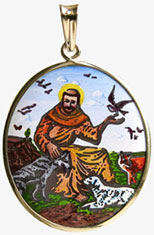 Francis of Assisi (real name Giovanni Battista Bernardone), also known as Francesco, was a monk, founder of the Franciscan Order and mystic.
Francis of Assisi (real name Giovanni Battista Bernardone), also known as Francesco, was a monk, founder of the Franciscan Order and mystic.
Saint Francis is the patron saint of Assisi, Italy and Philippines. He is the patron saint of ecology and conservationists. He is often called against headaches and against the plague. He is depicted as a man in a Franciscan robe, with stigmas or surrounded by animals, birds, wolves or lambs.
Saint Francis was the son of a wealthy merchant in Assisi and out of love for Christ left everything. At a time when materialism was growing also in the Orders of the Church, Francis began to renew faith by embarking on a path in absolute poverty and living according to the Gospel counsels. He founded a new Order of "Lesser Brothers" (Minorites also known as the Franciscan Order) and its Franciscan branches for women and lay people. The priority and highest value in his life was love. It was also connected with his harmony with nature. His deepest love for the Savior and his desire for the salvation of souls was complemented by the gift of stigma that made him even more like Christ. He died at the age of 44.
The world commemorates the feast of st. Francis on October 4.
The attributes of st. Francis include: crucifix, stigma, lamb, birds and wolf.
Saint Joseph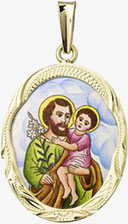 St. Joseph is one of the most revered saints after the Virgin Mary.
St. Joseph is one of the most revered saints after the Virgin Mary.
He is the patron saint of fraternities and religious societies named after him, Carmelites, also husbands and Christian families, children, youth and orphans, as well as virginity. He is the patron saint of workers, craftsmen, carpenters, lumberjacks, wheelwrights, engineers, gravediggers, educators, travelers and exiles, a protector in temptations, in desperate situations, in housing emergencies and eye diseases. He is the patron saint of the dying, for a good death. St. Joseph came from the royal family of David. By profession he was a carpenter or builder. He got engaged to Maria and when he learned that she was expecting a baby with him, he secretly wanted to leave. But an angel appeared to him in a dream and said, Joseph, son of David, do not be afraid to take Mary, your wife. For what was conceived in her is of the Holy Spirit. She will give birth to your son and you will give him the name Jesus. And he will save all people from their sins. When Joseph awoke, he married Mary. After the birth of Jesus, he was asked in a dream to flee with Mary and the child to Egypt and thus save himself from the persecution of Herod. In their virtuous marriage, their bond was God's love, which endowed them with a miraculously conceived fruit that became our salvation.
St. Joseph died in Nazareth before the public appearance of the Lord Jesus.
We celebrate St. Joseph's Day on March 19.
His attributes are: carpentry tools - saw, ax or angle, sometimes flowering stick or lily. He is often depicted with little Jesus in his arms and with a lily as a symbol of purity.
Saint Joseph Escrivá de Balaguer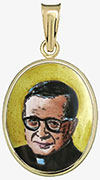 Spanish Catholic priest and founder of Opus Dei.
Spanish Catholic priest and founder of Opus Dei.
Full name José María Julián Mariano Escrivá de Balaguer y Albas was born in Barbastro, Spain on January 9, 1902. Saint Josemaría Escrivá opened a new path to holiness in the Catholic Church by teaching that men and women can to become saints in the performance of their work and in the performance of daily duties in the Christian spirit.
Pope John Paul II. blessed Mons. Escriva on May 17, 1992. Ten years later, on October 6, 2002, he canonized him in front of a large crowd in St. Peter's Square in Rome. On that occasion, the pope said in his homily: "Follow him in his footsteps and spread in society the knowledge that we are all called to holiness, regardless of race, class, culture and age." Joseph Escrivá died in Rome, 1975 and we commemorate him on June 26.
The attributes are priestly vestments and a rosary.
Saint Rita of Cascia Saint Rita is the patroness of desperate and infertile women. Invoked in hopeless situations and difficult trials, in marital problems.
Saint Rita is the patroness of desperate and infertile women. Invoked in hopeless situations and difficult trials, in marital problems.
She was born as Margherita Lotti in Roccaporena, Italy to a middle class family. When she was very young, she married a member of a wealthy patrician family. After an eighteen-year marriage, she tragically lost her husband and sons. She decided to enter the monastery and give up all ties to secular life.
She also began to lead an exemplary life based on helping the poor. She succeeded in reconciling her husband's murderers. According to legend, st. John the Baptist, st. Augustine and st. Nicholas the Tolentine appeared to her and opened the gates of the monastery to her. In 1443, stigmas appeared on her, as well as a wound on her forehead, reminiscent of the wounds from Jesus' crown of thorns. After her death, she was buried in the shrine at Cascia, which bears her name. A verse biography of Rita's miracles, including her authentic portrait, has been preserved to this day. We commemorate the memory of st. Rita on May 22.
The attributes are a religious habit and a rosary, sometimes also a book.
Saint Thérèse of Lisieux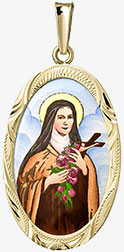 Saint Therese of Lisieux with her religious name Therese of the Child Jesus and the Holy Face, sometimes referred to as "Theresa of Jesus", was a French nun. Now she is worshiped as a Catholic saint, virgin and mystic and a great figure of the Carmelite Order. She is also known as the Little Flower of Jesus or just the Little Flower.
Saint Therese of Lisieux with her religious name Therese of the Child Jesus and the Holy Face, sometimes referred to as "Theresa of Jesus", was a French nun. Now she is worshiped as a Catholic saint, virgin and mystic and a great figure of the Carmelite Order. She is also known as the Little Flower of Jesus or just the Little Flower.
Pope John Paul II. declared her a teacher of the church in 1997 (Doctor Amoris). She is the patroness of tuberculosis and AIDS patients, florists and rose growers, orphans, and during the World War II also pilots and all aviation personnel, missions, missionaries, Carmelites and the whole of France and Australia. Saint Therese was born on January 2, 1873 in Alencon as Thérése Martin. She grew up in a Catholic family and attended the Benedictine school in Lisieux. When she was 9 years old, her sister Paolin, whom Therese considered her second mother, entered the Carmelite convent in Lisieux. Paolin was later followed by the oldest of the Martin sisters Maria. From childhood, Therese felt a vocation to consecrated life and, like her sisters, longed to become a Carmelite. At the age of 15, Therese was exceptionally accepted into the Order of Carmelites. In 1927, Pope Pius XI. declared Therese of Lisieux to be "the main patron of missions around the world" even though she did not move away from her monastic seclusion from her age of 15. On May 3, 1944 (just before the liberation of France), Pope Pius XII. described Therese as "the second patroness of France along with Joan of Arc". We commemorate the feast of st. Therese on October 1.
The attributes of st. Therese are religious clothing, a cross and a rose, so it is often depicted.
Saint Zdislava of Lemberk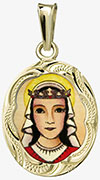 Saint Zdislava of Lemberk was a Czech noblewoman and the founder of monasteries and hospitals.
Saint Zdislava of Lemberk was a Czech noblewoman and the founder of monasteries and hospitals.
Her father was Pribyslav from Krizanov in Moravia and her mother was Sibyl, originally from Sicily, who came to the Czech lands with Kunhuta Stauf, the bride of King Wenceslas I.
Saint Zdislava is the patroness of families, the congregation of Dominican sisters, the diocese of Litomerice and the entire Czech nation.
Zdislava was probably a strong and energetic woman. Her name is associated with the Dominican monasteries in Turnov and Jablonne v Podjestedi, here also with the hospital. Which, despite its high position, personally visited and took care of the sick. She died prematurely at about 33 years of age. She was buried in the church of holy Lawrence in Jablonne, which construction began. Unfortunately, she could not see the completion of its construction. In 1907 she was declared blessed and in 1995 she was proclaimed by Pope John Paul II. for the saint.
Saint Zdislava of Lemberk is commemorated on May 30.
The attribute can be a model of a church.
Virgin Mary Mother of Perpetual Help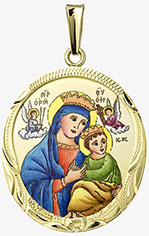 The image of the Virgin Mary, the Mother of Perpetual Succor is one of the most widespread forms of the Virgin Mary in general. The origins of this icon come from the 15th century Crete. Today, the original painting is located in the church of St. Alfonso in Rome. Many Marian devotees around the world are attached to the image of the Virgin Mary of the Perpetual Help. The image has a golden background, it represents the Holy Spirit and his permanence. The red colour of the dress is a symbol of love and the blue cloak is a sign of faith. The child's green dress represents divinity. Above the Mother of God are the archangels Michael and Gabriel. From the face of the Madonna you can read the deep suffering, but also the selfless love of the Mother. The attributes include a golden crown on the Madonna's head. The Mother of Perpetual Help as the Mother of Jesus Christ is worshiped throughout the world.
The image of the Virgin Mary, the Mother of Perpetual Succor is one of the most widespread forms of the Virgin Mary in general. The origins of this icon come from the 15th century Crete. Today, the original painting is located in the church of St. Alfonso in Rome. Many Marian devotees around the world are attached to the image of the Virgin Mary of the Perpetual Help. The image has a golden background, it represents the Holy Spirit and his permanence. The red colour of the dress is a symbol of love and the blue cloak is a sign of faith. The child's green dress represents divinity. Above the Mother of God are the archangels Michael and Gabriel. From the face of the Madonna you can read the deep suffering, but also the selfless love of the Mother. The attributes include a golden crown on the Madonna's head. The Mother of Perpetual Help as the Mother of Jesus Christ is worshiped throughout the world.
Virgin Mary Untier of Knots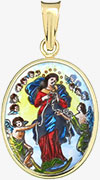 The patroness of the marriage, Virgin Mary Untier of Knots, has its origins in the story of the salvation of the marriage of Wolfgang and Sofia, which took place in the middle of the 17th century. Their happy grandson Hieronymus Ambrosius Langenmantel then, out of gratitude, painted a picture of a saint who saved the marriage of his ancestors. This image of the Virgin Mary Undoer of Knots is in St. Peter's Church in Augsburg to this day.
The patroness of the marriage, Virgin Mary Untier of Knots, has its origins in the story of the salvation of the marriage of Wolfgang and Sofia, which took place in the middle of the 17th century. Their happy grandson Hieronymus Ambrosius Langenmantel then, out of gratitude, painted a picture of a saint who saved the marriage of his ancestors. This image of the Virgin Mary Undoer of Knots is in St. Peter's Church in Augsburg to this day.
The attributes of the Virgin Mary Untier of Knots are the ribbon with the knots and the angels surrounding the image of the Virgin Mary untying these knots.




